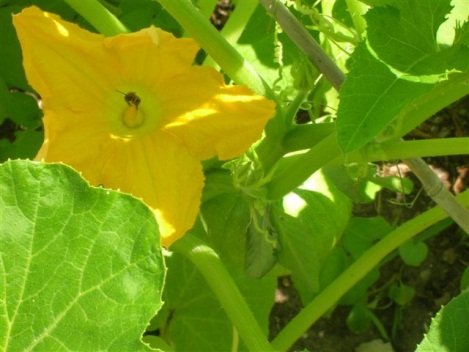Seeking alternative pollinators
Some plants require specialists to help in the pollination process.
While many of us are spending time looking for pest insects in our gardens we should also be looking for beneficial insects, too. This includes those insects that are helping to pollinate the flowers. Most plants cannot pollinate themselves, so the pollen grains must be carried from flower to flower of the same species in some way, through wind, water, animals or insects. With the decline of honey bees it is important that we find ways to attract those other alternative pollinators that can help do the job of pollination in our gardens.

Pollinators are important in the garden.
Photo credit: Cindy Murphy, Master Gardener volunteer
Honey bees are helpful pollinators in many crops but not all crops are easily pollinated by honey bees. Some plants such as blueberries and tomatoes need specialty pollinators that can “buzz” the flower, making the pollen drop out rather than go in to collect it. Bumble bees are better at this than honey bees making them valuable for setting fruit in these crops. Other plants might depend solely on flies to pollinate, such as the Pawpaw or the Cocoa tree.
If you do not have the right species or enough native bees in your area, various bees can be obtained from commercial suppliers to release in your home garden or orchard. Bumble bees and blue orchard bees (mason bees) are probably the most common alternative pollinators available commercially. There are a number of different bees that live in Michigan that switch easily between your garden and native plants. It is easy to attract and support these bees with native plants and other flowers that are selected to bloom at a variety of times during the summer.
Other organisms not generally thought of as pollinators are butterflies, wasps, beetles and humming- birds. While these organisms are not great at pollination, they do contribute to the process. Some are specialists, for example many beetles only visit one kind of plant or flower. They are important because they may be the only insect out and about in the early spring when a particular flower is blooming or they may be able to access tiny flowers such as those on Queen Anne’s lace or on Goldenrod. Beetles can also bite a hole in tightly closed flower blossoms gaining access to the nourishment inside.
The difference in the size, shape or color of the flower determines which pollinators can access it for nourishment. Long narrow flowers require organisms with long tongues or proboscis. Smaller delicate flowers require short proboscis or a smaller insect like a sweat bee or a hover fly. Some flowers seem perfectly suited for humming birds and others require the weight of a bumble bee to open them enough to expose the pollen for collecting. Any animal that visits a flower for its nectar or pollen is a potential pollinator including various birds, lizards and bats.
Whichever way you look at it supporting a diverse ecosystem is the only way to promote pollination by alternative species. You can help by reducing pesticide use targeting only pest species when they are actively present. Follow package label directions – more is not better. Plant native gardens and encourage areas of wild spaces on your property to encourage alternative pollinators to visit. Spend some time learning to appreciate the diversity in your own backyard.
For more information about gardening in Michigan visit the Gardening in Michigan website.
Here are some resources you can reference if you are seeking more information:



 Print
Print Email
Email


